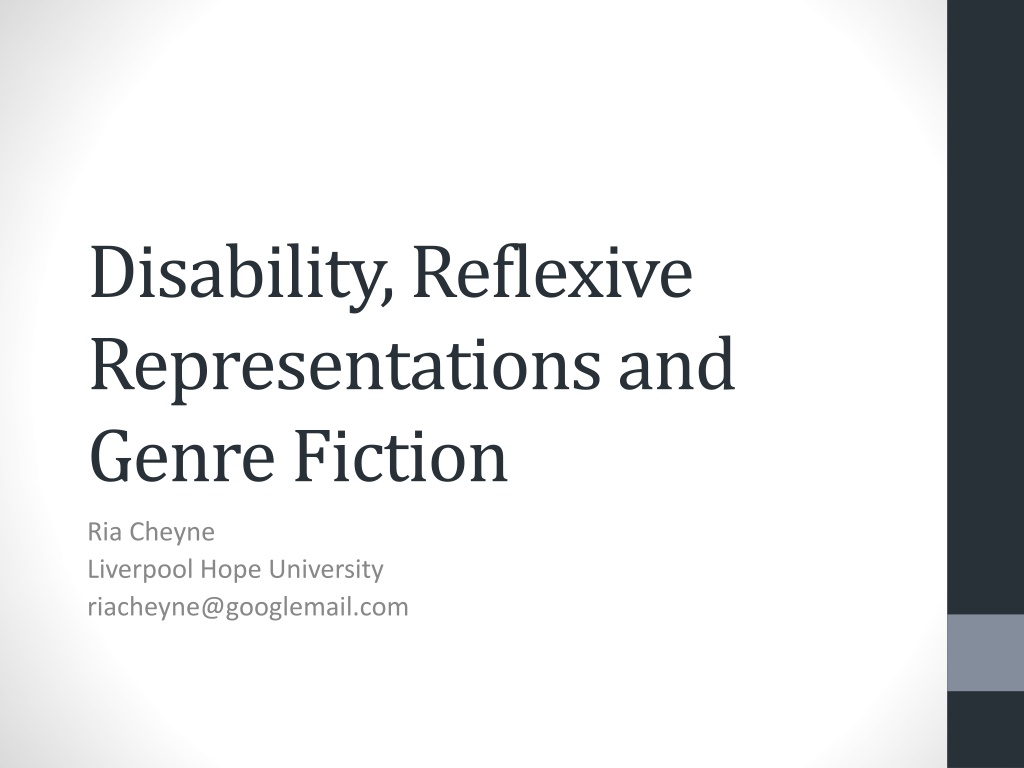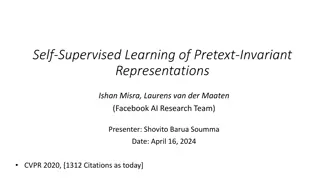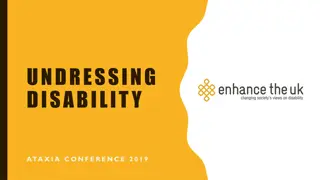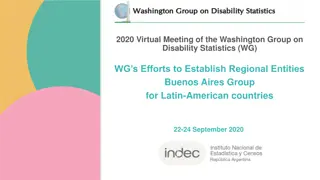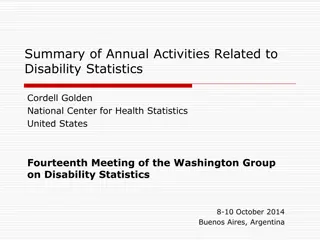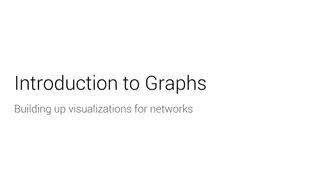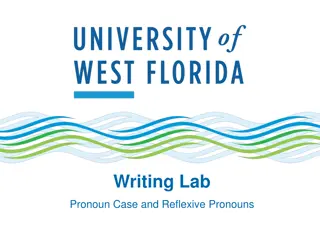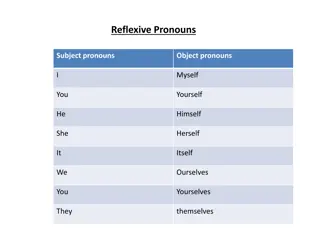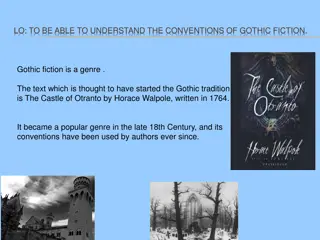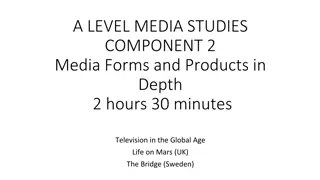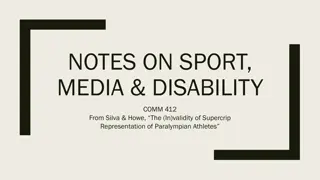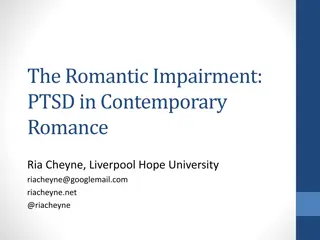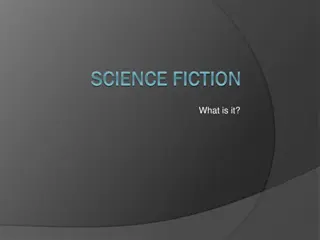Disability, Reflexive Representations in Genre Fiction: Exploring Cultural Perspectives
Disability studies, a vital academic discipline, delves into societal perceptions and policies around disability, challenging norms through evaluative and positive-image approaches. This exploration includes cultural analysis, critical assessments, and nuanced representations in genre fiction, offering a deeper understanding of disability identities and experiences.
Download Presentation

Please find below an Image/Link to download the presentation.
The content on the website is provided AS IS for your information and personal use only. It may not be sold, licensed, or shared on other websites without obtaining consent from the author. Download presentation by click this link. If you encounter any issues during the download, it is possible that the publisher has removed the file from their server.
E N D
Presentation Transcript
Disability, Reflexive Representations and Genre Fiction Ria Cheyne Liverpool Hope University riacheyne@googlemail.com
Disability Studies the academic counterpart to disability rights advocacy. It aims to do the work of research and critical analysis necessary to any effort at social reconstruction. It critically analyses the ideas about disability that have shaped societal organization and public policies, cultural values, and architectural design, individual behavior and interpersonal encounters, professional training and delivery of services. (Longmore, Why I Burned My Book, 2).
Cultural Strand Longmore, Screening Stereotypes (1985) Gartner and Joe, Images of the Disabled, Disabling Images (1987) Zola, Any Distinguishing Features? (1987) Morris, Pride Against Prejudice (1991) Barnes, Disabling Imagery and the Media (1992) Hevey, The Creatures Time Forgot (1992)
1995 1997 2000
Three claims Evaluative approaches have never really gone away only underground The case against evaluative approaches has been overstated Evaluative approaches still have much to contribute to cultural disability studies
Positive-image approaches: Representations unsettle conventional notions of normality and disability (Squier 71) necessitate interactions between reader and text that allow for fuller understanding of disabilities as they exist in relation to society (Birge) Offer a nuanced take on the human body and its diverse forms (Popp 37)
Evaluative Arguments Jablonski [...] complicate[s] dominant understandings of disability, turning away from facile metaphorizations and instead developing depictions that interrogate disability identity s complex relationship to the tradition of disability representation. (Hosey 37) Collins s writing of physical difference [...] constitutes an early comment on and a potentially transformative critique of those modern practices (and resulting cultural forms) which in their origin intend to define, designate, medicalize, control and exclude the body that is physically and cognitively different. (Mossman 483-484) This essay [ ] demonstrate[s] how graphic fictions articulate the embodied, ethical, and sociopolitical experiences of impairment and disability. [ ] these graphic novels unsettle conventional notions of normality and disability. (Squier 71)
Critiques of negative/positive image approaches Even images intended positively might have negative consequences. Can t classify a representation as positive or negative without understanding the historical context in which it was produced and received. Different audiences will understand different portrayals differently It might be fairly easy to identify negative images, but it s much harder to agree on what a positive image might be. (Paraphrasing Mitchell and Snyder, Narrative Prosthesis)
Critiques of negative/positive image approaches Even images intended positively might have negative consequences. Can t classify a representation as positive or negative without understanding the historical context in which it was produced and received. Different audiences will understand different portrayals differently It might be fairly easy to identify negative images, but it s much harder to agree on what a positive image might be. (Paraphrasing Mitchell and Snyder, Narrative Prosthesis)
Critiques of negative/positive image approaches Even images intended positively might have negative consequences. Can t classify a representation as positive or negative without understanding the historical context in which it was produced and received. Different audiences will understand different portrayals differently It might be fairly easy to identify negative images, but it s much harder to agree on what a positive image might be. (Paraphrasing Mitchell and Snyder, Narrative Prosthesis)
Critiques of negative/positive image approaches Even images intended positively might have negative consequences. Can t classify a representation as positive or negative without understanding the historical context in which it was produced and received. Different audiences will understand different portrayals differently It might be fairly easy to identify negative images, but it s much harder to agree on what a positive image might be. (Paraphrasing Mitchell and Snyder, Narrative Prosthesis)
Reflexive Representations Conceptualisation Prejudice Problematisation Access
Conceptualisation Humans had accomplished a great deal, despite the immense handicaps they struggled under (194). Amy Thomson, Through Alien Eyes (1999)
Prejudice some people feared and despised me more than they would fear or despise a three- eyed Toad Man in any carnival freak show (297) So many thoughtless people have made unkind assumptions about me, based on my appearance and my affinity for the night, that I am reluctant to join the club of cruelty (38) Dean Koontz, Fear Nothing (1997)
Problematisation Megan Galloway had broken her neck while still in her teens. She became part of the early development of a powered exoskeleton, research that had led to the hideously expensive and beautiful Golden Gypsy, of which only one was ever built. It abolished wheelchairs and crutches for her. It returned her to life, in her own mind, and it made her a celebrity (380) The world was briefly treated to the sight of quadriplegics dominating a new art form (380)
Problematisation Bach had thought her cure was complete, but now she wondered. Galloway carried a beautiful crystal cane. It didn t seem to be for show. She leaned on it heavily, and made her way through the tables slowly (380-381) John Varley, Tango Charlie and Foxtrot Romeo (1986)
Access Zola on crime fiction: Soon, some protagonist with a limp, a touch of emphysema or arthritis, or a missing limb will confront a long flight of stairs without a banister and will mutter, God dammit, how I hate stairs! (246)
Reflexive Representations and Relearning Disability is not what most of us commonly think it is. People with disabilities are not who or what we have been taught to assume they are. The experience of disability is not what we have been told. Most of the conventional wisdom about disabled people is wrong. [ ] All of us, disabled and nondisabled alike, will never truly understand disability experiences and identities unless we examine what we think we know. We all have a lot of relearning to do. (Longmore, Why I Burned My Book, 13-14).
